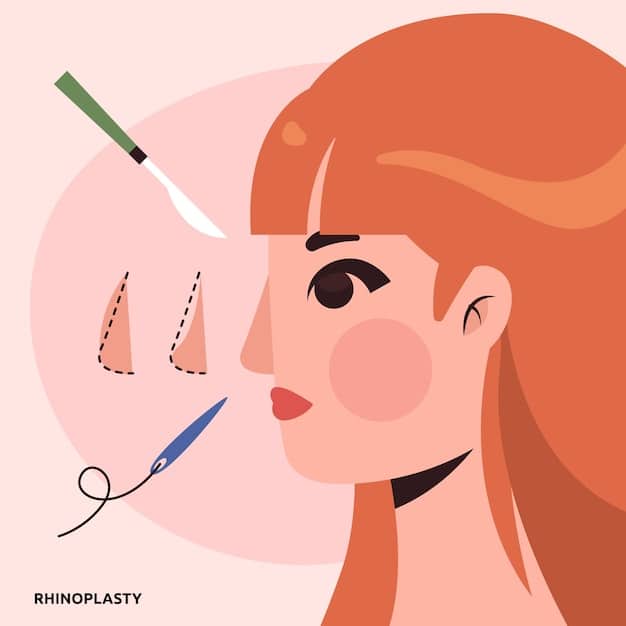Lip Lift 2025: Shorten Upper Lip Space by 30%?

Lip lift techniques in 2025 aim to reduce the distance between the nose and upper lip by approximately 30%, utilizing advanced surgical methods for enhanced facial aesthetics and a more youthful smile.
Interested in how cosmetic surgery might change the appearance of your lips? The buzz around lip lift techniques in 2025 can shorten the space between your nose and upper lip by 30% is growing. Let’s explore what this involves, who might be a good candidate, and what to anticipate.
Understanding the Evolution of Lip Lift Procedures
Lip lift procedures have come a long way, with continuous advancements aimed at refining outcomes and reducing recovery times. The goal is to create a more balanced and aesthetically pleasing facial appearance.
Traditional Lip Lift Techniques
Traditional methods involve surgically altering the skin above the upper lip to shorten the distance to the nose. While effective, these techniques can sometimes result in noticeable scarring.
Advancements in Surgical Approaches
Modern approaches focus on minimizing scarring and optimizing the natural appearance of the lips. Surgeons are now using techniques that provide more subtle and natural-looking results.
- Improved incision techniques to hide scars.
- Use of advanced suturing methods for better healing.
- Customized approaches tailored to individual facial anatomy.
The evolution of lip lift procedures highlights a shift towards less invasive and more refined methods, ensuring patients achieve their desired aesthetic outcomes with minimal side effects. These advancements also focus on long-term results, maintaining the lip’s enhanced appearance over time and adapting to the natural aging process.

Lip Lift Techniques Projected for 2025
Looking ahead to 2025, lip lift techniques are expected to incorporate cutting-edge technologies and refined surgical methods. These advancements promise even better results and quicker recovery periods.
The Bullhorn Lip Lift
This technique involves removing a section of skin just below the nose in the shape of a bullhorn. It’s designed to lift the entire upper lip, enhancing its shape and visibility.
The Corner Lip Lift
A corner lip lift focuses on lifting the corners of the mouth, addressing downturned lips that can create a sad or tired appearance. This technique involves small incisions at the corners of the mouth to elevate them.
- Use of 3D modeling to plan precise excisions.
- Incorporation of dissolvable sutures for reduced follow-up visits.
- Development of topical treatments to minimize scarring.
The projected advancements in lip lift techniques for 2025 emphasize precision and patient comfort. By integrating technological innovations, surgeons aim to deliver outcomes that are both aesthetically pleasing and functionally beneficial, contributing to a more confident and rejuvenated smile.
How a Lip Lift Can Shorten the Upper Lip Space by 30%
The targeted reduction of the space between the nose and upper lip is a key goal in lip lift procedures. Achieving a 30% reduction can significantly enhance facial harmony and create a more youthful appearance.
Precision and Planning
Achieving a 30% reduction requires careful planning and precise surgical execution. Surgeons use detailed measurements and imaging to determine the exact amount of skin to remove.
Surgical Execution
During the procedure, the surgeon meticulously removes the planned amount of skin, ensuring symmetry and a natural-looking lift. The incisions are carefully closed to minimize scarring.
The success of a lip lift in achieving a 30% reduction in the upper lip space depends on a combination of factors, including the patient’s individual anatomy, the surgeon’s skill, and the specific technique used. When performed correctly, this reduction can dramatically improve the overall aesthetics of the face, resulting in a more balanced and attractive smile.

Ideal Candidates for Lip Lift Procedures
Determining who is an ideal candidate for a lip lift involves assessing various factors to ensure the procedure aligns with their aesthetic goals and overall health.
Age and Skin Elasticity
Ideal candidates are typically those who have good skin elasticity and are experiencing age-related changes in their upper lip position.
Facial Structure
Individuals with a longer-than-average distance between their nose and upper lip, or those with a naturally thin upper lip, may benefit significantly from a lip lift.
- Those seeking to increase the visibility of their upper teeth.
- Individuals with realistic expectations about the outcomes of the procedure.
- Non-smokers, as smoking can impair healing.
Identifying suitable candidates for lip lift procedures requires a thorough understanding of facial anatomy and aesthetic principles. By carefully evaluating each patient’s unique characteristics and goals, surgeons can ensure the procedure is both safe and effective, leading to high levels of satisfaction with the results.
The Recovery Process and Expected Results
Understanding the recovery process and having realistic expectations about the results are crucial for a successful lip lift experience. Proper care and adherence to post-operative instructions are essential.
Immediate Post-Op Care
In the initial days following the procedure, patients can expect some swelling, bruising, and discomfort. Pain medication can help manage any discomfort.
Long-Term Results
As the swelling subsides, the results of the lip lift will become more apparent. The upper lip will appear fuller, and the distance between the nose and upper lip will be reduced.
The recovery process following a lip lift is a gradual journey that requires patience and diligence. While the immediate post-operative period may involve some discomfort, the long-term results can be transformative, providing a more youthful and balanced facial appearance that enhances self-confidence and overall quality of life.
Potential Risks and How to Mitigate Them
Like any surgical procedure, lip lifts carry potential risks. Being aware of these risks and understanding how to mitigate them is essential for ensuring a safe and successful outcome.
Common Risks
Common risks include infection, scarring, asymmetry, and changes in sensation. Choosing an experienced and qualified surgeon can minimize these risks.
Mitigation Strategies
Following pre- and post-operative instructions carefully, as well as promptly reporting any concerns to the surgeon, can help prevent complications.
- Choosing a board-certified and experienced surgeon.
- Undergoing a thorough pre-operative evaluation.
- Following all post-operative care instructions.
Addressing potential risks associated with lip lift procedures requires a proactive and informed approach. By working closely with a skilled surgeon and taking necessary precautions, patients can significantly reduce their risk of complications and achieve their desired aesthetic outcomes with confidence.
| Key Aspect | Brief Description |
|---|---|
| 🎯 Goal of Lip Lift | Shorten space between nose & upper lip. |
| 🔪 Bullhorn Technique | Excising skin under the nose to lift the lip. |
| 🤕 Recovery | Expect swelling; results visible as it subsides. |
| ⚠️ Potential Risks | Infection, scarring; mitigate with a skilled surgeon. |
Frequently Asked Questions About Lip Lift Procedures
▼
The primary goal is to shorten the distance between the base of the nose and the upper lip, increasing the visibility of the upper teeth and creating a more balanced facial appearance.
▼
A lip lift procedure typically takes about one to two hours to complete, depending on the specific technique used and the individual patient’s anatomy.
▼
The initial recovery period involves swelling and bruising, which usually subsides within a week. Full recovery and final results can be seen within a few months.
▼
Yes, the results of a lip lift are generally considered permanent, as the procedure involves physically altering the position and shape of the upper lip.
▼
Potential risks include scarring, infection, asymmetry, and changes in lip sensation. These risks can be minimized by choosing an experienced and qualified surgeon.
Conclusion
Lip lift techniques in 2025 offer promising advancements for those seeking to enhance their facial aesthetics. By understanding the procedures, identifying as an ideal candidate, and being aware of the potential risks, individuals can make informed decisions and achieve satisfying results.





